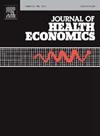女子中学助学金方案对儿童健康的影响
IF 3.6
2区 经济学
Q1 ECONOMICS
引用次数: 0
摘要
在这项研究中,我们研究了1994年女性中学助学金计划(FSSSP)对孟加拉国儿童健康投入和儿童健康结果的代际影响。先前的研究表明,FSSSP显著提高了农村女孩的中等教育水平。应用基于出生队列和农村居住差异的差异暴露差异的差异中差模型,我们发现,与不符合条件的母亲相比,有资格获得5年补贴的母亲的孩子的完全免疫接种率提高了4.2个百分点,但对只有2年补贴的母亲的孩子没有显著影响。我们还发现,其他健康投入(如产前保健)和儿童健康结果(如死亡率)也有所改善。我们还探讨了婚姻、生育、自主、劳动力供应和媒体曝光等方面的变化,这些变化可能有助于观察到儿童健康的改善。本文章由计算机程序翻译,如有差异,请以英文原文为准。
The impact of the Female Secondary School Stipend Program on child health
In this study, we examine the inter-generational effects of the 1994 Female Secondary School Stipend Program (FSSSP) on child health inputs and child health outcomes in Bangladesh. Prior studies have shown that the FSSSP significantly increased secondary schooling among rural girls. Applying a difference-in-differences model based on differential exposure to FSSSP by birth cohort and rural residence, we find that full immunization rates increased by 4.2 percentage points among children of mothers eligible for a stipend for 5 years relative to children of mothers who were not eligible, but there were no significant effects for children of mothers eligible for a stipend for only 2 years. We also find improvements in other health inputs (e.g., antenatal care) and in child health outcomes (e.g., mortality). We also explore changes in marriage, fertility, autonomy, labor supply, and media exposure, which may contribute to the observed improvements in child health.
求助全文
通过发布文献求助,成功后即可免费获取论文全文。
去求助
来源期刊

Journal of Health Economics
医学-卫生保健
CiteScore
6.10
自引率
2.90%
发文量
96
审稿时长
49 days
期刊介绍:
This journal seeks articles related to the economics of health and medical care. Its scope will include the following topics:
Production and supply of health services;
Demand and utilization of health services;
Financing of health services;
Determinants of health, including investments in health and risky health behaviors;
Economic consequences of ill-health;
Behavioral models of demanders, suppliers and other health care agencies;
Evaluation of policy interventions that yield economic insights;
Efficiency and distributional aspects of health policy;
and such other topics as the Editors may deem appropriate.
 求助内容:
求助内容: 应助结果提醒方式:
应助结果提醒方式:


